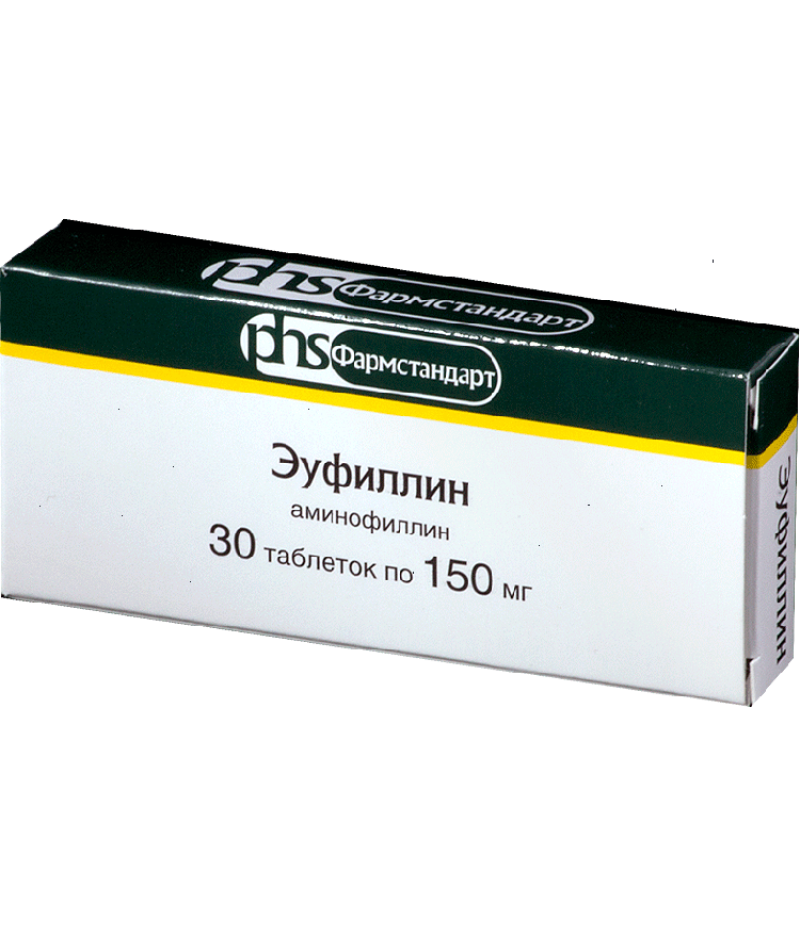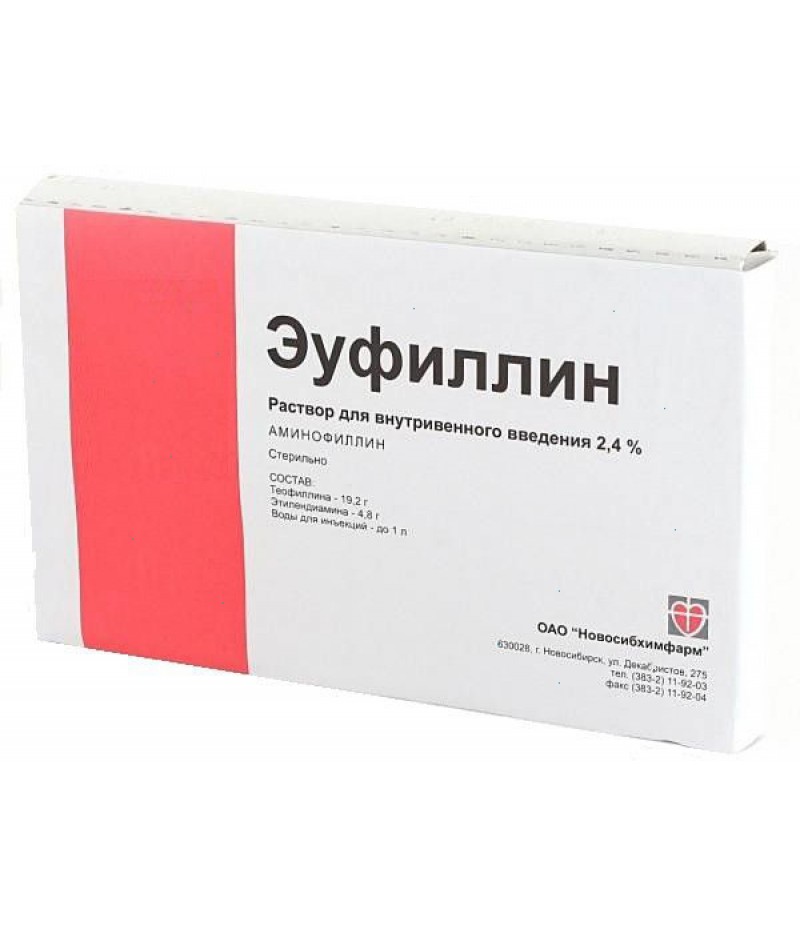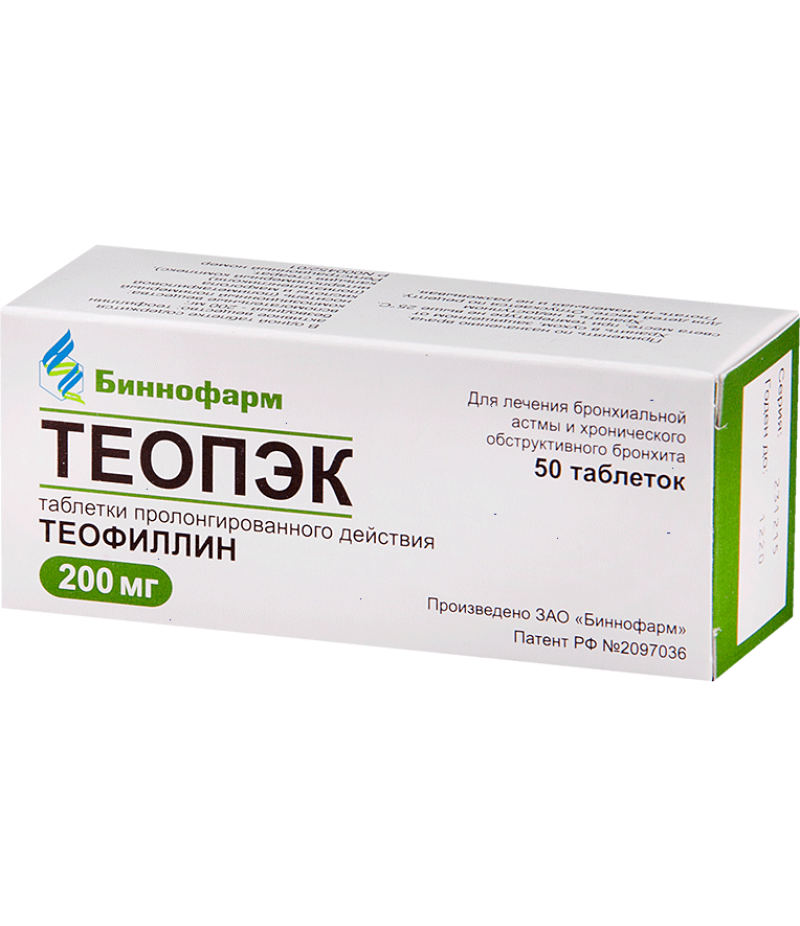Euphyllin tabs 150mg #30
- $0.99
- Availability:In Stock
Euphyllin tabs user manualReed more and buy Euphyllin tabs onlineCompositionOne tablet contains 150 mg of active substance, as well as calcium stearic acid and potato starch.Form of issueTablets of 150 mg (packaging No. 10 and No...
Tags: tabs
Euphyllin tabs user manual
Reed more and buy Euphyllin tabs online
Composition
One tablet contains 150 mg of active substance, as well as calcium stearic acid and potato starch.
Form of issue
Tablets of 150 mg (packaging No. 10 and No. 30).
Injection solution Euphyllin 2.40% in ampoules 5 ml (package No. 10, No. 50 and No. 100) and 10 ml (package No. 10).
pharmachologic effect
Bronchodilator, tocolytic, spasmolytic, diuretic. Refers to a group of drugs for systemic use in diseases that are accompanied by obstruction (non-passable syndrome) of the respiratory tract.
Clinical and pharmacological group (according to Vidal's guide): a bronchodilator means an inhibitor of PDE. The pharmaceutical subgroup is xanthines.
Pharmacodynamics and pharmacokinetics
The mechanism of action of aminophylline (in Latin - aminophylline) is associated with its ability to block the purine (adenosine) receptors of the A2-type smooth muscle cells of the bronchi, increase the accumulation in the tissues of cyclic AMP, suppress PDE, reduce the intake of Ca ions through the channels of plasmalemmas (cell membranes), reduce the contractile smooth muscle activity.
Effects of the drug manifest themselves as:
relaxation of the musculature of the bronchi;
stimulation of contractions of the diaphragm;
increased mucociliary clearance;
improvement of the function of the intercostal and respiratory muscles;
stimulation of the respiratory center and increase of its sensitivity to CO2;
improvement of alveolar ventilation.
All this helps to reduce the severity and reduce the frequency of episodes of stopping respiratory movements (apnea).
Normalizing breathing, provides better oxygen saturation of blood and helps to reduce the concentration of CO2. Stimulates the activity of the heart muscle, increases the number and strength of its contractions, improves blood circulation through the blood vessels of the heart and increases the need for myocardium in oxygen.
Reduces the stress of the vascular walls, promotes the expansion of peripheral vessels, reducing vascular resistance in the lungs, reducing pressure in the small (pulmonary) circulation.
It is a diuretic of moderate force, increases blood flow in the kidneys, promotes bile duct dilatation, suppresses platelet aggregation, increases erythrocyte resistance to deformation (improves blood rheology), normalizes microcirculation and reduces thrombus formation.
Reduces excitability and contractility of myometrium (tocolytic effect), in high doses has an epileptogenic effect.
Absorption from the gastrointestinal tract with ingestion is rapid. Food does not change its value, but it reduces the speed. The degree of absorption depends also on the dose: the higher it is, the slower aminophylline is absorbed.
In a healthy adult, about 60% of the dose of aminophylline is associated with plasma proteins, in a patient with cirrhosis of the liver - about 35%, in infants during the newborn - 36%.
TSmah for regular tablets - 60-120 minutes.
In the liver, part of the accepted dose of aminophylline is biotransformed into caffeine. T1 / 2 caffeine in children under 3 years old is longer than in adults. The concentration of the substance in the child can reach 30% of the concentration of aminophylline.
In patients older than three years of age, the phenomenon of cumulative caffeine is not observed.
The T1 / 2 index is affected by the concomitant diseases and age of the patient. In children under the age of six months, as well as in adults with heart failure, COPD and pulmonary heart disease, it is more than 24 hours, in children older than six months of age - 3.7, in non-asthmatic adults - 8.7, in smokers more than 20 cigarettes a day, 4-5 hours. After quitting smoking for normalization of the pharmacokinetics of the drug takes at least 3 months.
Eliminated by the kidneys, in pure form in adults, about 10%, and children - about half the dose of aminophylline.
Indications for use of Euphyllin
Euphyllin - from what these pills?
bronchial asthma (BA);
Pickwick's syndrome (nocturnal paroxysmal apnea);
chronic obstructive bronchitis (COB);
chronic "pulmonary heart";
emphysema of the lungs.
Euphyllin is a drug of choice in AD of physical stress, with other forms of the disease it is used in combination with other drugs.
Contraindications to tablets Euphyllin
intolerance to aminophylline or any other xanthine derivatives;
myocardial infarction (MI) in acute stage;
hypertrophic cardiomyopathy with obstruction;
tachyarrhythmia;
exacerbation of symptoms of the stomach / 12-colon;
severe functional impairment of kidney / liver;
epilepsy;
hyperthyroidism.
Pediatrics are not prescribed for children younger than six years of age, and also in combination with "fadrin.
Side effects
Side effects of the use of tablets of Euphyllin:
sleep disorders, anxiety, dizziness, convulsions, tremor;
heart rhythm disturbance, palpitations;
hematuria, albuminuria;
hypoglycemia (rarely).
Euphyllin tablets: instructions for use
Vidal's guide indicates that the pill should be taken orally after a meal with plenty of fluids. The dosage of the drug is selected individually, taking into account the different rates of excretion of aminophylline in different patients.
If necessary, the dose is increased every three days until the desired effect is achieved.
Patients with a body weight of more than 50 kg (including adolescents) Euphyllin with bronchitis and others, accompanied by bronchial obstruction, are prescribed to take 450-900 mg / day, if necessary, the dose can be increased to 1.2 g with a multiplicity of 4 r ./day. with an interval of 6 hours.
Patients weighing less than 50 kg and adolescents weighing between 45-55 kg, Euphyllin in tablets prescribe to take 450-600 mg / day.
Children 6-17 years old with bronchitis and other bronchial obstructive conditions, the tablets are given at the rate of 13 mg / kg, usually 1 tablet 3 r. / Day.
With COPD in the acute phase, treatment starts with a dose of 5-6 mg / kg (for an adult) with further increase. Serum concentration should not exceed 0.02 mg / ml. An increase in the dose for every 0.5 mg / kg leads to an increase in the concentration of the drug in the blood at 0.001 mg / ml.
Outside the exacerbation, the initial dose of Euphyllin for an adult with COPD is 6-8 mg / kg / day, the highest (at the initial stages of treatment) is 400 mg / day. It is recommended to divide it for 3-4 reception.
In case of use in pregnancy, the dosage (as well as the mode of administration) is determined by the doctor. It should be borne in mind that for a mother an overdose is associated with a risk of cardiac dysfunction (and sometimes even a stop), and for a fetus, high doses of Euphyllin are dangerous because of the possibility of hypoxia and antenatal death.
Electrophoresis with Euphyllin
Euphyllin for electrophoresis in adults is used to treat arthrosis and osteochondrosis. For electrophoresis, children are prescribed for dysplasia, as well as when it is necessary to remove hypertonic muscle or reduce intracranial pressure.
With insufficient cerebral circulation or intracranial hypertension, it is performed on the cervical vertebrae, with hypertension of the legs in the child - on the lumbar region.
Electrophoresis with Euphyllin is a procedure that allows you to create the right concentration of the active substance directly in the affected tissues. Acting point-by-point, the medicine does not cause systemic side effects, due to which it is allowed to be used in infants over the month.
The doctor applies a gauze cloth moistened in a solution of Euphillin and fixes the electrodes to the sore spot. The exposure time is 15 minutes. This is enough to penetrate the tissue deep into the tissues. The course of treatment is designed for ten sessions.
To restore the function of organs after birth injuries in newborn children, blood circulation of the brain in pathologies of the cervical spine, as well as in cerebral palsy, electrophoresis according to Ratner is recommended.
The essence of this method is that the patient is impregnated with two pads saturated with different drugs: the first (with a 0.5% solution of Euphyllin) - on the cervical vertebrae, the second (with a solution of papaverine 1%) - on the ribs, to the right of the sternum. The exposure time is 15 minutes. The current strength is 1-2 mA.
It should be noted that both children and adults alike tolerate the procedure equally well, therefore, in the absence of contraindications, it can be carried out without any fear.
Electrophoresis is contraindicated in any skin diseases, arterial hypertension, arrhythmia, heart failure, the presence of new malignancies in the patient (any localization).
Inhalation with Euphyllin to children - effective or impractical?
The appointment of children with coughing and obstruction of the bronchial tubes of the Euphyllin allows to expand the bronchi, remove the spasm and facilitate the departure of sputum. However, these effects have a means only if they get into the systemic bloodstream.
The use of Euphyllin for inhalations is classified as "off-label" prescribing. Despite the lack of instructions in the manufacturer's instructions regarding the possibility of using the drug in this way, many people often prescribe themselves such treatment and, moreover, treat their children in this way.
Most doctors agree unanimously: the effectiveness of inhalations with Euphyllin is extremely low, because when inhaled, the drug settles on the mucosa and, therefore, does not enter the systemic circulation at a therapeutically effective concentration.
The positive effect on the bronchi (their relaxation and improvement of sputum evacuation) is due to the fact that during the inhalation they get water vapor. This means that the effectiveness of the drug with inhalation is comparable to that of ordinary water.
Euphyllin tabs from cellulite
One of the properties of aminophylline is the ability to expand peripheral vessels and restore the circulatory system, which in turn can not. And cellulite, as is known, blood circulation is disrupted, and cells begin to suffer from a lack of oxygen. The use of Euphyllin allows you to tighten the upper layers of the skin, remove excess fluid and reduce swelling.
For weight loss and getting rid of the orange peel, the product is used in the form of creams, masks and wraps. A good effect also gives a massage with Euphyllin.
To prepare the composition, the drug should be mixed with any massage cream, and then add a small amount of Dimexide, which in this case will act as a transporter (thanks to it, aminophylline can penetrate very deeply into the tissue).
For wraps, you can use a mixture of regular baby cream, Dimexide, Euphyllin and essential oil of mandarin or lemon (6-8 drops). The composition is applied to the skin cleaned with scrub and covered with a food film. While it will "work" (the exposure time is usually about 30 minutes), it is recommended to intensively move to enhance the effect.
To prepare an anti-cellulite cream based on Euphyllin, use the following recipe:
petrolatum;
moisturizing cream;
1 powdered tablet or contents of 1 ampoule (5 ml) of Euphyllin (this dose is suitable for women weighing less than 75 kg);
Dimexide (for one five-milliliters ampoule solution should take 2 ml of Dimexide concentrate).
You can also add the drug to the finished pharmacy anti-cellulite. The optimal proportion of ingredients is 1: 5.
Reviews about Euphyllin from cellulite can be found very different - someone is completely unhappy with the result, someone assures that the result has surpassed all expectations. Starting from this, we can draw the following conclusion - if the tool works, then, definitely, not with the first procedure.
Overdose
The annotation indicates that overdose symptoms develop when the plasma concentration of aminophylline exceeds the value of 0.02 mg / ml. Typical are:
diarrhea;
prolonged vomiting;
hyperemia of the face;
excitation;
arrhythmia;
tremor;
photophobia;
convulsions.
When the concentration in the blood exceeds 0.04 mg / ml, the patient falls into a coma.
The help includes stopping the patient from administering Euphyllin and increasing natural detoxification by stimulating the work of the kidneys (forced diuresis).
If the level of aminophylline exceeds 0.05 mg / ml, plasmapheresis, hemosorption, peritoneal dialysis or hemodialysis, respiratory support (ventilation and oxygen delivery), monitoring of hemodynamic parameters are indicated.
To stop the convulsive syndrome, the patient is given diazepam (intramuscularly). The use of barbiturates is contraindicated!
Interaction
Aminophylline is enhanced by the use in combination with furosemide, ephedrine, caffeine, β-adrenostimulants.
With simultaneous application with phenytoin, phenobarbital, isoniazid, rifampicin, sulfinpyrazone, carbamazepine, acceleration of aminophylline metabolism is observed, which is accompanied by a decrease in its therapeutic efficiency and may require an increase in the applied dose.
Acceleration of aminophylline metabolism is also noted in heavy smokers (at least 20 cigarettes a day).
The use of macrolides, allopurin, isoprenaline, COC, cimetidine, lincomycin, viloxazine, fluvoxamine, disulfiram, beta-adrenergic blockers, and influenza vaccines leads to a delay in elimination of aminophylline, an increase in its plasma concentration and, consequently, a decrease in the applied dose of Euphyllin.
In case of prescribing the drug in combination with fluoroquinolone group preparations, the dose of Euphyllin is reduced to 25% of the usually recommended dose.
Aminophylline weakens the therapeutic effect of drugs Li and β-adrenoblockers. β-adrenoblockers in turn weaken the bronchodilating effect of aminophylline.
When taking Euphyllin together with SCS (for example, with dexamethasone), diuretics and β-adrenomimetics, the risk of developing hypoglycemia increases.
Aminophylline can provoke the occurrence of side effects of fluorinated derivatives for general anesthesia (ventricular arrhythmias), mineral corticosteroids (hypernatremia), CNS-inducing drugs (neurotoxicity).
Can enhance the effect of anticoagulants.
The solution is incompatible with solutions of acids, fructose, glucose and levulose. When preparing for an intravenous infusion of an infusion solution, the pH of the solutions used must be taken into account.
With caution should be used in combination with derivatives of purine, theophylline derivatives, anticoagulants. During the treatment it is forbidden to take substances that contain xanthines (including tea and coffee).
In one syringe, the solution of Euphyllin can only be mixed with an isotonic NaCl solution.
Terms of sale
You can buy online Euphyllin without a prescription.
Storage conditions
List B. Store in a light and waterproof place at room temperature.
Shelf life - two years.
special instructions
The bronchodilating effect of the drug is manifested when the concentration of the active substance reaches 0.01-0.02 mg / ml. Toxic is a concentration exceeding 0.02 mg / ml.
Exciting effect on the respiratory center is realized when the content of aminophylline in the blood is in the range from 0,005 to 0,01 mg / ml.
Newborn infants and people over 55 years of age, the drug is used with caution because of insufficient activity of the enzyme systems of the liver involved in biotransformation of aminophylline.
In geriatrics, Euphyllin should be used in minimal doses in conditions of monitoring the plasma concentration of aminophylline.
During the period of treatment, do not eat foods that contain xanthine derivatives: mate, chocolate, coffee, cocoa, strong tea.
The solution is heated to the body temperature before administration.
With alcohol
Alcohol increases the completeness and speed of absorption.
Euphyllin tabs during pregnancy
The manufacturer in the instructions to Euphyllin warns that the use of a solution / tablets during pregnancy can cause the creation of potentially fetal / newborn infant concentrations of aminophylline and caffeine.
Children whose mothers received the drug during pregnancy (especially in her third trimester) should be under medical supervision during the newborn period to monitor possible symptoms of intoxication with methyl xanthines.
The appointment of Euphyllin in pregnancy and lactation is possible only for extreme life indications and requires an assessment of the possible risks to the fetus / child.
Why can Euphyllin be prescribed during pregnancy?
Gynecologists recommend the use of Euphyllin for edema in pregnancy, with placental insufficiency, in the complex therapy of gestosis, as well as in other conditions requiring the urgent use of this medication because of the threat to the life of the mother.
A clear scheme of treatment with Euphyllin during pregnancy does not exist, because in the manufacturer's instructions pregnancy is marked as one of the contraindications to the use. All the appointments the doctor makes, depending on the condition of the particular patient.
Reviews of Euphyllin during pregnancy lead to the conclusion that the medicine is far from being harmless (some women say that after a dropper they felt a strong palpitation, weakness and dizziness), but many people are helping to get back to normal.
Reviews about Euphyllin tabs
The drug is most often used to treat diseases accompanied by airway obstruction, so most of the reviews about Euphyllin are reviews about its use in bronchitis and asthma.
People who take medicine note that the remedy cures seizures of a painful cough, speeds up excretion of sputum and facilitates breathing. And the improvement comes already literally within 10 minutes after taking the pill or injecting the solution.
In pregnancy (if properly applied in accordance with the doctor's recommendations), the medicine helps to remove excess fluid, normalize the condition and avoid hospitalization in the department of pregnancy pathology.
Negative reviews of the drug are few and related primarily to individual sensitivity to its active ingredient.
A separate category of reviews about Euphyllin is feedback on the use of tablets and a solution for weight loss and against cellulite. In cellulite, the drug is used as an additive to the main anti-cellulite drug, as well as in combination with Dimexide and essential oils.
To judge the effectiveness of Euphyllin from cellulite is difficult, because feedback on the results of its use in cosmetology is quite contradictory. Most women claim that to achieve smoothness of the skin with the drug can be, but the effect becomes noticeable usually after the completion of the full course of procedures.



